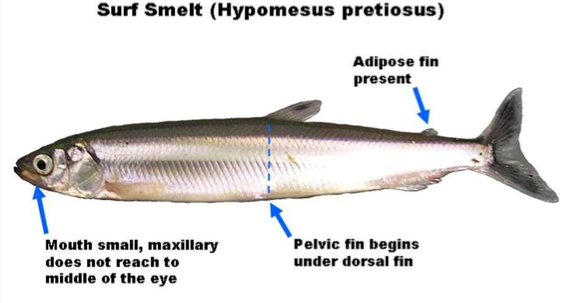A healthy shoreline is good for human security, ecology and economics, and Bowen’s shores have a lot of potential, says biologist Ramona DeGraaf. DeGraaf sampled soft-sediment beaches all around Bowen last October to assess their suitability for forage fish spawning, and delivered the results to council this week.
“I sampled 75 beach units, with a beach unit being an area no more than 300 metres long. Fourty beach units I sampled equalling 3.4 kilometers, are amenable for surf smelt or Pacific sand lance spawning,” says De Graaf. “Being a Howe Sound Island, the shoreline is mostly made up of hard rock, limiting the amount of shoreline that is available in the first place.”
De Graaf explained to council that sandy, gravely beaches as well as the subtidal zone with eelgrass beds and other seaweeds act as critical habitat for forage fish, who lay their eggs in these areas. These fish (surf smelt, Pacific sand lance and herring) provide the critical link in the coastal food chain, converting zooplankton into food for animals at higher levels at higher levels. For example, sand lance and herring account for up to 78 percent of a Chinook salmon’s diet.
One of the Bowen beaches that stands out for De Graaf is Tunstall Bay.
“It is one of the outstanding beach areas in Howe Sound for forage fish production, and in that, it is critical to the health of the Salish Sea,” she says. “It has a sandy gravel beach, and a shallow subtidal zone that’s excellent for eelgrass and herring spawning. When it comes to valued ecosystem components, Tunstall Bay has all of them.”
One of the beach’s challenges, she says, is the stretch that separates Tunstall from Sealeigh beach.
“In order to secure docks and piers, the waterfront property owners have used large boulders to stop erosion,” says De Graaf. “But in the past 15 years, new technology has been developed that maintains the soft-shoreline and effectively mitigates erosion. In any case, sea-level rise is going to force change in areas like this. I’d like to see it done in a way that creates a win-win situation for the ecosystem and for people who want to use the beach.”
On the subject of sea-level rise, DeGraaf points to Mannion Bay as another example of an area that will be forced to change.
“Now might be the time to start a conversation that might last for five years, about how the bay is going to cope with all the existing pressures, plus the pressures that can be expected with predicted sea level rises,” says De Graaf. “It would be a challenge, but I think Mannion Bay could be a prime location for a major habitat restoration project that would be as good for people as it is the ecosystem. I think Mannion Bay is ripe for something really great.”
De Graaf says that for her, working with local governments is the best way to get traction in terms of protecting critical habitat for forage fish.
“There are so many tools we have within local governments, and I think we just need to expand on those. At this point, we have Land Use Planning, why not Beach Use Planning in coastal communities? This would benefit fish, people and the economy.”
Municipal Councillor Sue Ellen Fast says that these ideas already fit in with several of council’s strategic priorities.
“In 2015, surveying Bowen’s shoreline to figure out where docks are appropriate and where they are not appropriate is already on the agenda,” says Fast. “Next year we plan to tackle the hazardous slopes bylaw. These both fit in to the category of shoreline protection.”



